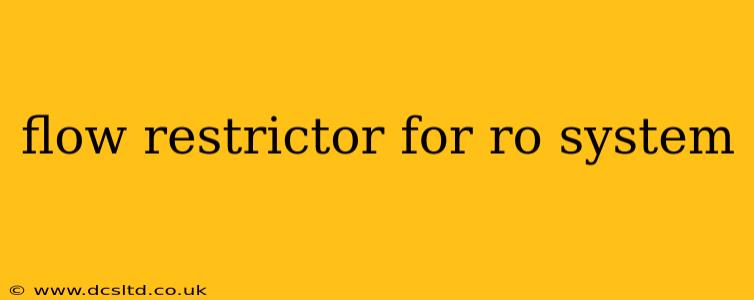Reverse Osmosis (RO) systems are popular for providing clean, purified water. However, the efficiency and longevity of your RO system can be significantly impacted by water pressure. This is where a flow restrictor comes in. This guide explores flow restrictors for RO systems, addressing common questions and concerns.
What is a Flow Restrictor in an RO System?
A flow restrictor, also known as a flow reducer or pressure regulator, is a small device installed in your RO system's plumbing. Its primary function is to control the rate at which water flows through the system. By reducing the water pressure entering the RO membrane, it protects the membrane from excessive pressure, preventing damage and extending its lifespan. A properly functioning flow restrictor ensures the RO membrane operates within its optimal pressure range, leading to higher quality purified water and improved efficiency. Think of it as a pressure valve specifically designed for your RO system's delicate components.
Why is a Flow Restrictor Important for my RO System?
The importance of a flow restrictor in your RO system cannot be overstated. Here's why:
- Membrane Protection: High water pressure can damage the RO membrane, leading to premature failure and costly replacements. The restrictor acts as a buffer, preventing excessive pressure from reaching the membrane.
- Improved Water Quality: By maintaining optimal pressure, the flow restrictor ensures the RO membrane can effectively filter impurities, resulting in higher-quality purified water.
- Increased System Lifespan: Protecting the membrane from damage naturally extends the overall lifespan of your RO system, saving you money on repairs and replacements.
- Consistent Production: A flow restrictor helps maintain a consistent flow rate of purified water, preventing fluctuations in pressure that can affect the quality and quantity of your output.
What Happens if my RO System Doesn't Have a Flow Restrictor?
Operating an RO system without a flow restrictor can lead to several issues:
- Membrane Damage: The most significant consequence is potential damage to the RO membrane due to excessive pressure. This can lead to membrane failure and require costly replacement.
- Reduced Water Quality: High pressure can overwhelm the membrane, resulting in less effective filtration and lower-quality purified water.
- Shorter System Lifespan: The constant stress on the membrane will drastically shorten the overall lifespan of the system.
- Waste Water Issues: You might experience significantly higher wastewater production, leading to water waste and increased operational costs.
How Does a Flow Restrictor Work in an RO System?
A flow restrictor works by creating resistance to the water flow. This resistance reduces the water pressure before it reaches the RO membrane. Different types of restrictors use various methods to achieve this pressure reduction, but the fundamental principle remains the same: controlled water flow equals membrane protection.
What are the Different Types of Flow Restrictors?
While the specific design may vary between manufacturers, flow restrictors generally fall into a few categories:
- Adjustable Flow Restrictors: These allow you to fine-tune the water flow rate based on your specific needs and water pressure.
- Fixed Flow Restrictors: These provide a predetermined flow rate and are less adjustable.
How to Choose the Right Flow Restrictor for Your RO System?
Choosing the right flow restrictor depends on several factors:
- Your RO System's Specifications: Consult your RO system's manual to determine the recommended flow rate and pressure.
- Your Water Pressure: High water pressure requires a more effective restrictor.
- Your Water Consumption: Higher water consumption might necessitate a higher flow rate.
How to Install a Flow Restrictor in an RO System?
Installing a flow restrictor usually involves simple plumbing adjustments. However, it's always recommended to refer to your specific RO system's instructions and potentially consult a professional plumber if you're unsure about the process. Improper installation can negate the benefits and potentially damage your system.
Can I Adjust the Flow Restrictor Myself?
Adjustable flow restrictors allow for some level of user adjustment. However, it's crucial to understand the impact of adjusting the flow rate and avoid making significant changes without understanding the consequences. Consult your system’s manual for guidance on adjustment.
How Often Should I Replace my Flow Restrictor?
The lifespan of a flow restrictor varies, depending on water quality and usage. Regular inspection and replacement, as needed, is essential for maintaining optimal system performance. If you notice a significant decrease in purified water output or suspect malfunction, replacing the restrictor might be necessary.
This comprehensive guide provides a solid foundation for understanding the role and importance of flow restrictors in RO systems. Remember to always consult your specific RO system's manual for detailed instructions and recommendations. By understanding and properly utilizing a flow restrictor, you can maximize the performance, lifespan, and efficiency of your RO system, ensuring you enjoy clean, safe drinking water for years to come.
